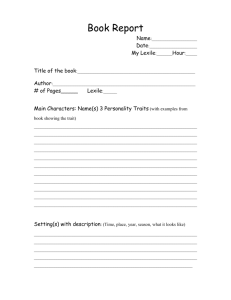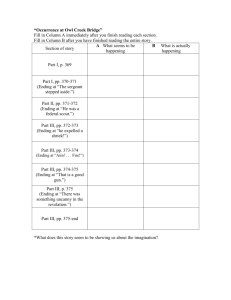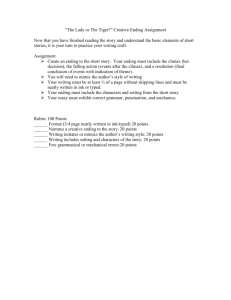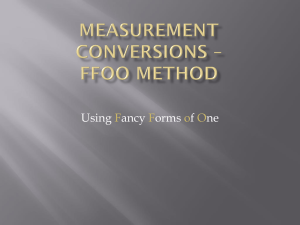document
advertisement
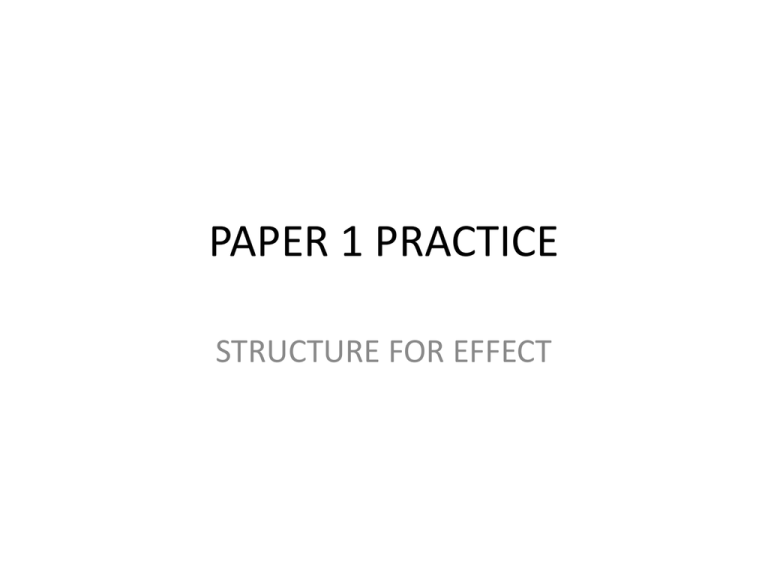
PAPER 1 PRACTICE STRUCTURE FOR EFFECT LESSON OBJECTIVES I MUST: understand the function of openings and endings I SHOULD: identify features contained in openings and endings I COULD: explain Doris Lessing’s opening and ending and the impact on the reader STARTER Read the following and work out whether they are opening or endings to stories. Try and match them together and for a bonus point name the novel they come from! We thought a little longer, and in the end we simply called her Joy. So Lyra and her daemon turned away from the world they were born in, and looked towards the sun, and walked into the sky. You will rejoice to hear that no disaster has accompanied the commencement of an enterprise which you have regarded with such evil forebodings. I found him in the garage on Sunday afternoon. It was the day after we moved into Falconer Road. The winter was ending. He sprang from the cabin window as he said this, upon the ice raft which lay close to the vessel. He was soon borne away by the waves and lost in darkness and distance. Lyra and her daemon moved through the darkening Hall, taking care to keep to one side, out of sight of the kitchen. STARTER Read the following and work out whether they are opening or endings to stories. Try and match them together and for a bonus point name the novel they come from! We thought a little longer, and in the end we simply called her Joy. (ENDING) So Lyra and her daemon turned away from the world they were born in, and looked towards the sun, and walked into the sky. (ENDING) You will rejoice to hear that no disaster has accompanied the commencement of an enterprise which you have regarded with such evil forebodings. (OPENING) I found him in the garage on Sunday afternoon. It was the day after we moved into Falconer Road. The winter was ending. (OPENING) He sprang from the cabin window as he said this, upon the ice raft which lay close to the vessel. He was soon borne away by the waves and lost in darkness and distance. (ENDING) Lyra and her daemon moved through the darkening Hall, taking care to keep to one side, out of sight of the kitchen. (OPENING) STARTER - ANSWERS How did you work out whether they were openings or endings? What clues in the writing gave it away? Solid settings, introduction of character... PAIR WORK In pairs choose whether to be an opening or ending. Decide on a storyline and individually write your part of the story – the opening or the ending. When it is complete, in a different colour, label/annotate what you have written giving reasons for your choices. What effect did you hope to have on the reader? EXAMPLE - OPENING I found him in the garage on a Sunday afternoon. It was the day after we moved into Falconer Road. The winter was ending. Mum had said we’d be moving just in time for the spring. Nobody else was there. Just me. The others were inside the house with Doctor Death, worrying about the baby. EXAMPLE - ENDING So Lyra and her daemon turned away from the world they were born in, and looked towards the sun, and walked into the sky. THE IMPORTANCE OF OPENING AND ENDINGS Why do we have clear openings and endings in stories? Complete the following sentences explaining what we find in openings and endings. OPENINGS: The purpose of an opening is..... ENDINGS: The purpose of an ending is.... SUNRISE ON THE VELD - OPENING The boy stretched his body full length, touching the wall at his head with his hands, and the bedfoot with his toes; then he sprung out, like a fish leaping from water. And it was cold, cold. The opening of the story introduces the main character stretching himself upon waking. After reading the whole story however, this could be seen as a metaphor of how the boy is growing up; he is almost too long for his bed! The leap out of bed returns us to his childish ways but the final short, dramatic sentence seems to contain more depth than just referring to the cold air. It suggests that the adult, mature world which he discovers later in this story, is a cold place which is emphasised by the use of repetition. SUNRISE ON THE VELD - ENDING For a moment he was a small boy again, kicking sulkily at the skeleton and hanging his head. At last he picked up his gun and walked homewards. He was telling himself defiantly that he wanted his breakfast. He was telling himself that it was getting very hot, much too hot to be roaming the bush. He walked heavily, not looking where he put his feet. When he came within sight of his home, he stopped, frowning. There was something he had to think out. The death of that animal was a thing that concerned him, and he was by no means finished with it. It lay at the back of his mind uncomfortably. Soon, the very next morning he would get clear of everybody and go back to the bush to think about it. ANALYSIS OF THE ENDING The ending of the story is very different to the beginning as it shows us how the boy has changed. He is thinking about what he had witnessed and trying to work it out. At first he tries to take the easy option of ignoring the unpleasantness trying to pretend it is not there, but the word “sulkily” tells us that deep down he realises that to cause unnecessary suffering is wrong and that was what he had set out to do at the start of the day. He tries to avoid these conclusions by thinking adult phrases such as “it was getting too hot” to be outdoors. When he stops upon seeing his home and is “frowning” this suggests that he feels strange with this new realisation and needs more time to understand the adult world. The vocabulary in the final paragraph is very different to the start of the story which was full of hope and excitement; now the words suggest thought and understanding, taking responsibility for actions. The ending of the story contains the moral or deeper meaning and links to the opening which contained the repeated word “cold”. PLENARY Read out the openings and endings. Work out which it is and what features it contains. Refer to lesson objectives. I MUST: understand the function of openings and endings I SHOULD: identify features contained in openings and endings I COULD: explain Doris Lessing’s opening and ending and the impact on the reader

